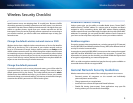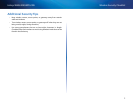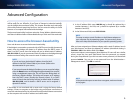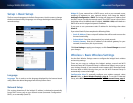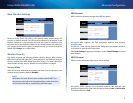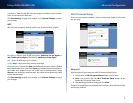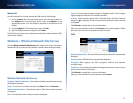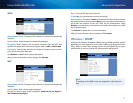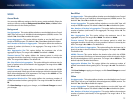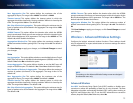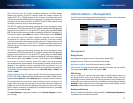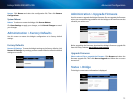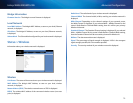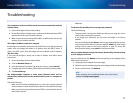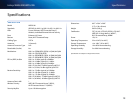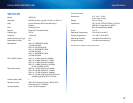
12
Advanced Configuration
Linksys WES610N/WET610N
WMM
Access Mode
You can assign different settings to the four access modes available. Select the
mode you want to configure: Background, Best Effort, Video, or Voice. Follow
the instructions for the mode you select.
Background
Use Aggregation This option defines whether or not the Media Access Control
(MAC) layer will set up an Add Block Acknowledgement (ADDBA) session. The
default is No. Select Yes to enable this option.
Accept Aggregation This option defines whether or not the MAC layer will
accept an ADDBA request. The default is Yes. Select No to disable this option.
Max. Number of Packets in Aggregation This option defines the maximum
number of packets (sub-frames) in the aggregate. The range is 0 to 7. The
default is 7.
Max. Aggregation Size This option defines the maximum size of the
aggregate (in bytes). The range is 0 to 16000. The default is 12000.
Timeout Internal This option defines the timeout period in which the
aggregate should be closed with a “closing condition” before it is closed by the
timer. The range is 0 to 100 ms. The default is 3.
Min. Size of Packet in Aggregation This option defines the minimum size (in
bytes) of packets to be accumulated in the aggregate. The range is 0 to 1500.
The default is 10.
ADDBA Timeout This option defines the duration after which the ADDBA
setup is terminated, if there are no frame exchanges within this duration by the
Block Acknowledgement (ACK) agreement. The range is 0 to 65535 ms. The
default is 0, which disables the timeout.
Aggregation Window Size This option defines the maximum number of
packets transmitted without getting ACKs. The range is 0 to 64. The default is
64.
Click Save Settings to apply your changes, or click Cancel Changes to cancel
your changes.
Best Effort
Use Aggregation This option defines whether or not the Media Access Control
(MAC) layer will set up an Add Block Acknowledgement (ADDBA) session. The
default is Yes. Select No to disable this option.
Accept Aggregation This option defines whether or not the MAC layer will
accept an ADDBA request. The default is Yes. Select No to disable this option.
Max. Number of Packets in Aggregation This option defines the maximum
number of packets (sub-frames) in the aggregate. The range is 0 to 10. The
default is 10.
Max. Aggregation Size This option defines the maximum size of the
aggregate (in bytes). The range is 0 to 20000. The default is 16000.
Timeout Internal This option defines the timeout period in which the
aggregate should be closed with a “closing condition” before it is closed by the
timer. The range is 0 to 100 ms. The default is 3.
Min. Size of Packet in Aggregation This option defines the minimum size (in
bytes) of packets to be accumulated in the aggregate. The range is 0 to 1500.
The default is 10.
ADDBA Timeout This option defines the duration after which the ADDBA
setup is terminated, if there are no frame exchanges within this duration by the
Block Acknowledgement (ACK) agreement. The range is 0 to 65535 ms. The
default is 0, which disables the timeout.
Aggregation Window Size This option defines the maximum number of
packets transmitted without getting ACKs. The range is 0 to 64. The default is
64.
Click Save Settings to apply your changes, or click Cancel Changes to cancel
your changes.
Video
Use Aggregation This option defines whether or not the Media Access Control
(MAC) layer will set up an Add Block Acknowledgement (ADDBA) session. The
default is Yes. Select No to disable this option.
Accept Aggregation This option defines whether or not the MAC layer will
accept an ADDBA request. The default is Yes. Select No to disable this option.
Max. Number of Packets in Aggregation This option defines the maximum
number of packets (sub-frames) in the aggregate. The range is 0 to 7. The
default is 7.



